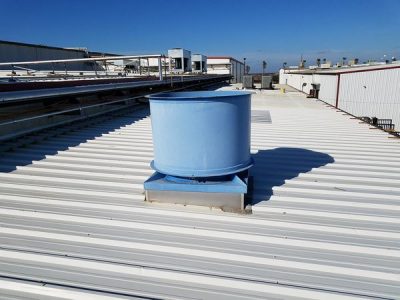IIAR 2-2021: Ammonia Machinery Room Ventilation Requirements

In 2021, IIAR published a new edition of their flagship standard ANSI/IIAR 2 which addresses the requirements for designing a safe ammonia refrigeration system. Machinery room ventilation is one of the many important topics addressed within Standard 2. While the requirements have not changed substantially since the 2014 edition, we have put together this blog to summarize the requirements applicable to the design of new ammonia refrigeration machinery room ventilation systems.
General
- Machinery rooms must be vented to the outdoors not less than 20 ft. from a property line or building opening.
- If air ducts are used, they must only serve the machinery room.
Fans
- Exhaust fans must be constructed so that two ferrous parts cannot rub or strike and create a spark. Aluminum fan blades satisfy this requirement.
- Fan motors must be of the totally enclosed type.
- Multiple fans or multiple speed fans are permitted, but not required, to achieve the design airflow.
Make-Up Air
- Outdoor make-up air must be provided to replace the air being exhausted.
- Make-up air must be sufficient to prevent the pressure inside the machinery room from exceeding 0.25 in. water column.
- Make-up air must be positioned to avoid short-circuiting air directly to the exhaust.
- Make-up air opening covers must not be less than ¼ in. mesh. Small screens or filters can be used if engineering or administrative controls are in place to ensure airflow and negative pressure requirements are met.
- Intakes for make-up air must serve only the machinery room.
- If used, motorized dampers must fail in the open position upon the loss of power.
- Where direct openings or openings with ducts are not provided to supply make-up air, make-up air must be provided by fans or fans with ducts.
Airflow Rate & Velocity
- When the machinery room is occupied, the ventilation rate should be the greater of 0.5 cfm/ft2 or 20 cfm/occupant.
- The emergency ventilation rate must be 30 air changes per hour (ACH). Reduced airflow is allowed if there is supporting engineering analysis.
- The temperature control ventilation rate must limit the room to 104ºF.
- All exhaust fans must discharge upwards at a velocity of 2,500 ft./min.
Control
- Emergency ventilation must be activated if the ammonia concentration reaches 150 ppm.
- A clearly identified “ON/AUTO” control switch for the emergency ventilation system must be located outside the principal machinery room door.
- Fans that are not part of emergency ventilation system should be de-energized if the ammonia concentration reaches 150 ppm.
- Temperature control ventilation must be continuous or activated by both of the following: 1) A thermostat measuring the machinery room temperature; 2) “ON/AUTO” control switch described in bullet point #1 if the temperature control ventilation will also contribute to emergency ventilation.
- A monitored location must be notified upon loss of power to the emergency ventilation system.
- The emergency ventilation system must be powered independently of other machinery room equipment and unaffected by the e-stop.
- A means of proving emergency airflow must be provided. Common examples include: (1) pressure differential switches, (2) sail switches, and (3) current monitors.

Leave a Reply